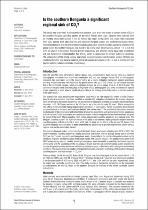JavaScript is disabled for your browser. Some features of this site may not work without it.
- ResearchSpace
- →
- Research Publications/Outputs
- →
- Journal Articles
- →
- View Item
| dc.contributor.author |
Gregor, L

|
|
| dc.contributor.author |
Monteiro, Pedro MS

|
|
| dc.date.accessioned | 2014-06-17T10:32:04Z | |
| dc.date.available | 2014-06-17T10:32:04Z | |
| dc.date.issued | 2013-05 | |
| dc.identifier.citation | Gregor, L and Monteiro, P.M.S. 2013. Is the Southern Benguela a significant regional sink of CO2? South African Journal of Science, vol. 109(5/6), pp 1-5 | en_US |
| dc.identifier.issn | 0038-2353 | |
| dc.identifier.uri | http://www.sajs.co.za/sites/default/files/publications/pdf/Gregor_Research%20Letter_2.pdf | |
| dc.identifier.uri | http://hdl.handle.net/10204/7468 | |
| dc.description | Copyright: 2013 AOSIS OpenJournals. This is an Open Access journal. The journal authorizes the publication of the information herewith contained. Published in AOSIS OpenJournals | en_US |
| dc.description.abstract | This study was undertaken to characterise the seasonal cycle of air–sea fluxes of carbon dioxide (CO(sub2)) in the southern Benguela upwelling system off the South African west coast. Samples were collected from six monthly cross-shelf cruises in the St. Helena Bay region during 2010. CO(sub2) fluxes were calculated from pCO(sub2) derived from total alkalinity and dissolved inorganic carbon and scatterometer-based winds. Notwithstanding that it is one of the most biologically productive eastern boundary upwelling systems in the global ocean, the southern Benguela was found to be a very small net annual CO(sub2) sink of -1.4 ± 0.6 mol C/m(sup2) per year (1.7 Mt C/year). Regional primary productivity was offset by nearly equal rates of sediment and sub-thermocline remineralisation flux of CO(sub2), which is recirculated to surface waters by upwelling. The juxtaposition of the strong, narrow near-shore out-gassing region and the larger, weaker offshore sink resulted in the shelf area being a weak CO(sub2) sink in all seasons but autumn (-5.8, 1.4 and -3.4 mmol C/m(sup2) per day for summer, autumn and winter, respectively). | en_US |
| dc.language.iso | en | en_US |
| dc.publisher | AOSIS OpenJournals | en_US |
| dc.relation.ispartofseries | Workflow;12745 | |
| dc.subject | Southern Benguela | en_US |
| dc.subject | Eastern boundary | en_US |
| dc.subject | Carbon dioxide | en_US |
| dc.subject | Ocean-atmosphere interaction | en_US |
| dc.subject | CO2 | en_US |
| dc.subject | Sediments | en_US |
| dc.title | Is the Southern Benguela a significant regional sink of CO2? | en_US |
| dc.type | Article | en_US |
| dc.identifier.apacitation | Gregor, L., & Monteiro, P. M. (2013). Is the Southern Benguela a significant regional sink of CO2?. http://hdl.handle.net/10204/7468 | en_ZA |
| dc.identifier.chicagocitation | Gregor, L, and Pedro MS Monteiro "Is the Southern Benguela a significant regional sink of CO2?." (2013) http://hdl.handle.net/10204/7468 | en_ZA |
| dc.identifier.vancouvercitation | Gregor L, Monteiro PM. Is the Southern Benguela a significant regional sink of CO2?. 2013; http://hdl.handle.net/10204/7468. | en_ZA |
| dc.identifier.ris | TY - Article AU - Gregor, L AU - Monteiro, Pedro MS AB - This study was undertaken to characterise the seasonal cycle of air–sea fluxes of carbon dioxide (CO(sub2)) in the southern Benguela upwelling system off the South African west coast. Samples were collected from six monthly cross-shelf cruises in the St. Helena Bay region during 2010. CO(sub2) fluxes were calculated from pCO(sub2) derived from total alkalinity and dissolved inorganic carbon and scatterometer-based winds. Notwithstanding that it is one of the most biologically productive eastern boundary upwelling systems in the global ocean, the southern Benguela was found to be a very small net annual CO(sub2) sink of -1.4 ± 0.6 mol C/m(sup2) per year (1.7 Mt C/year). Regional primary productivity was offset by nearly equal rates of sediment and sub-thermocline remineralisation flux of CO(sub2), which is recirculated to surface waters by upwelling. The juxtaposition of the strong, narrow near-shore out-gassing region and the larger, weaker offshore sink resulted in the shelf area being a weak CO(sub2) sink in all seasons but autumn (-5.8, 1.4 and -3.4 mmol C/m(sup2) per day for summer, autumn and winter, respectively). DA - 2013-05 DB - ResearchSpace DP - CSIR KW - Southern Benguela KW - Eastern boundary KW - Carbon dioxide KW - Ocean-atmosphere interaction KW - CO2 KW - Sediments LK - https://researchspace.csir.co.za PY - 2013 SM - 0038-2353 T1 - Is the Southern Benguela a significant regional sink of CO2? TI - Is the Southern Benguela a significant regional sink of CO2? UR - http://hdl.handle.net/10204/7468 ER - | en_ZA |






